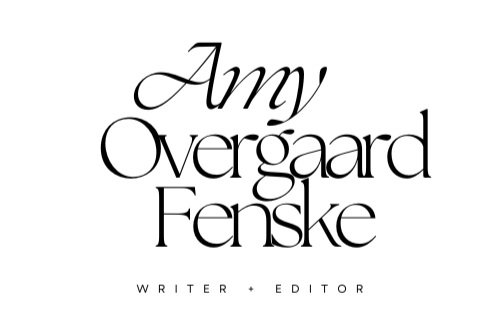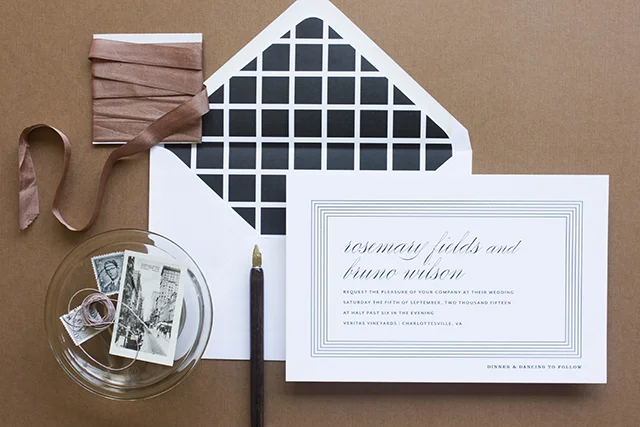Birds of a Feather: MaeMae & Co.
SEPTEMBER 2014
The other week we had the pleasure of chatting with Megan Gonzalez, owner of MaeMae & Co., and hearing about her company and beautiful design work, which focuses on wedding suites and branding projects.
Megan started MaeMae in 2008, during her senior year of college as a way to make some extra money, designing for other students on campus at Biola University in Southern California. After graduating, getting married, moving and hour and a half north of LA, and struggling to find full-time design work in her new city, she started pursuing her own design business more seriously. In 2012 she and her husband Jason moved to Minnesota—he got a job as a sports writer at the Star Tribune—and MaeMae moved with them. Since the relocation, Megan’s business has expanded to include three other employees—Katie, the studio assistant, Lori, the team designer, and Anna, the design apprentice—and the group of four recently moved out of their work space in Megan’s home into a loft-turned-office a few blocks away. Their stunning space is airy, full of light and inspiration, and very much reflects the aesthetic of the designs MaeMae creates.
We talked with Megan about her creative discovery process, how her role has changed over the years, and her favorite types of projects and clients. Check out the full interview below!
White Peacock: What is the scope of the work you do at MaeMae?
Megan: We started as a wedding stationery company, all custom, and then in 2012 moved into a ready-made wedding line, so that people could purchase designs and customize it—change the color, change their text, change the paper type and print method. And then, in 2010 I also started doing branding. It’s taken different shapes over time, and now what we do is focus on working with other businesses—mostly creative—and we help them when they feel kind of like they’re stuck. Like, they’re moving toward a different clientele or a different service, and they want to really elevate the brand, pretty much from the inside out. So we help them with their internal systems, their processes, strategy, and of course help with visuals—web design, logo and all that entails, and then stationary packaging, we help with photoshoots and do illustrations. So, the branding side has been really cool because we’re using a different side of the brain. It’s not just visuals; we do a lot, like a check-up on the inside of the business. So that’s been really fun. And then with weddings right now we’re kind of making a shift from more of the quirky style that it started out with to something that’s a bit more refined and suitable for more classic and high-end weddings, while keeping that layered and mismatched look that people really like from us. So, we’re kind of at a cool point, where there’s a lot of things that are still there from the start of the business that have just been refined and updated.
WP: How has your role shifted over the years?
M: With every client I’m involved in a different way. My goal would to be to work a lot on division of what’s next, get into product and help develop that, and work a lot with vendor relationships and making connections to bring new clients in. But I still do love concepting for projects—that’s my favorite, and I love meeting with clients. I still like everything, but it’s like, ok, I gotta do something else, otherwise we’ll just stay the same all the time.
WP: What is a favorite project or type of project that you’ve worked on?
M: I really love styling. We worked on this one project where Katie sourced a bunch of materials that we styled and shot with Wing from Canary Grey, that were the filler images on our website, and I thought that was really fun, to see an end-product that, everything on there, we did. I like projects like that in branding where we get to be like, yeah, we had a hand in everything on there. Like a full-service project. I really like it when we have clients that come to us with a vision for something that’s different than what everyone else is doing versus the clients that want to stay on-trend with things. We worked with a photographer recently who didn’t want to have a really feminine photography site—she wanted to hang with the guys and have a more polished and more masculine vibe. And I loved that. That’s my favorite site that we’ve done.
WP: What have been the biggest challenges in having your own business?
M: I think separating work and life is really hard. I think something that can be difficult is separating out what you like doing versus what your clients like you to do, and finding a happy medium there. I hit this one point where people would tell me, ‘Oh, that doesn’t look MaeMae enough.’ And that was quite a while ago now, but it always sticks with me. It just bugged me because at the time it was just me, and I was like, well, I’m MaeMae and I’m the only one making this, and can’t I change and grow? So, it’s defining your own personal taste and what you want to do versus what the clients want you to do. I think that’s difficult to figure out how do you change but still attract people, or if you’re going to go a totally different way you have to figure out how to reach new people.
WP: Greatest rewards?
M: I feel like I’ve just learned so much. In talking with other business owners or other creatives, I’ve begun to realize that, through the hard knocks, I’ve learned a lot. And there’s a lot of things outside of work that those lessons helped me as a person to improve and mature faster. So that’s been something that’s really good. And then I think, now that I have a team, the flexibility of having your own business is starting to come into play. It’s been really nice to feel like, ok, well I need to leave or something comes up, and I have other people there to support me and take over.
WP: How have you been able to strike a good work/life balance?
M: I’m definitely still working on it. I think one of the best things I did was get a separate line for my cell, and I don’t give clients my cell phone number. Not everybody who has a small business can work outside of their home, but for me that’s something that’s been really helpful. There would be times where, even if I wasn’t physically sitting at a desk at my house working, it was like I couldn’t turn my brain off because I could see things. So that’s been really helpful. And then, I think if you have it in you to have the self-discipline to say, these are my times I work, that’s fantastic. But then there’s other times where you’re just like, I’m in the middle of the project, I can’t stop. Or, if I leave, I’m going to be two weeks behind on work. You know what I mean? So, I don’t know, I’m still trying to figure it out.
But I think there’s also this element that you have to embrace as a creative, where you’re like, there’s a lot of overlap with work and life, and if you’re passionate about what you do as a creative, you’re going to hunger to want to make stuff and think about it and jot it down, and I think that’s something to embrace. You just have to be aware of when it starts influencing your happiness and other people who are important in your life, and that’s when you went too far.
WP: What is your creative process for new clients and discovering their personal style and taste?
M: The first thing we do is talk on the phone, in here, or on Skype. It’s just a time to get to know them. The next thing that we do is send the proposal, and it contains visual information and information about the timeline and the investment, and we also pair that with a written description about what we’re going to do. That way it hits on all levels—you see it, you read it, you see graphs about what we’re doing, so it kind of makes them understand what we’re wanting to do and sets our expectations at the same level. And then once we book them, we put them in the calendar and start working!
We’re trying to be really thorough in the prep, so that once we dive in to actually making stuff, we’ve already thought through so many things and know what the end product is supposed to look like. Whereas I think a lot of designers spend time in the process of “make, make, have it rejected or refine it,” our goal is to send people things that, the very first time they get it, they love it. Their expectations have been set up, so they know what they’re going to get. So, prepping is a big part of the whole process—lots of questions, several meetings even before they see any designs. That way, we can just cut to the chase. We want people to feel like we’re steering the project—you put it in our hands, so you’ll just be the yes and no person. So that’s been really helpful and exciting to see that that works when you just take a different stance with the client, instead of letting them think they’re directing the whole thing. Because they shouldn’t have to. And I think if you’re somebody who does like to direct, we’re just not the right people for you. And there are designers who don’t like to direct, so that’s why there are so many different people out there.
WP: Do you have a dream client you’d like to work with? If so, who would that be?
M: We’ve had a lot of dream clients recently. They’re people who saw something we do, so they love it, trust us, and then they come in and we glean what they’re looking for and deliver it. And because of that process, too, the first time we send them something they’re like, ‘Done. We love it.’ You know, that’s the dream client! And I think trust is the ultimate thing there. Because I think what we offer is so beyond a standard graphic design service, since we’re getting really in-depth and helping you solve problems and thinking big-picture. Like, if you have a blog, theses are the kinds of photos you should feature, these are what your subjects should be, this is what your tone should be. So, if they don’t trust us, we can’t deliver a final project that [we both love].

